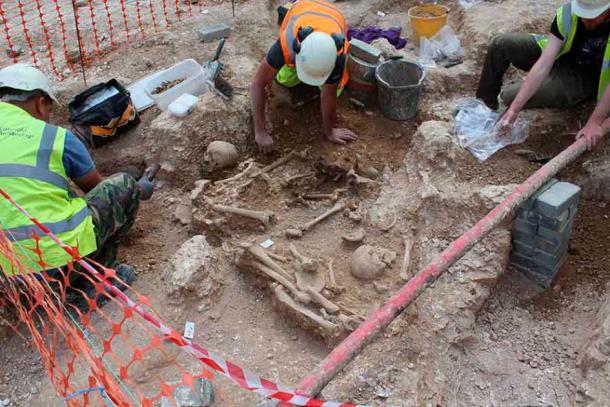
‘Bone Collector’ Sleuth Says Violent Deaths Evident in Mass Grave Under Irish Bar!
A bone expert investigating a mass grave in Ireland has found clear evidence of hyper-violence, including smashed bones and bound limbs. Last year, beneath Nancy Spain’s Public House, Barrack Street, Cork, Ireland, archaeologists unearthed a mass grave. Now, a bone expert detective has determined four of the men “met a violent end.”
For most of us, the only interaction we ever have with the word “osteo” is when discussing our mum’s and grannies' pains. This is because the science of osteopathy revolves around how bones, muscles, ligaments and connective tissues function together. However, in an Ancient Origins context, osteoarcheologists study human skeletons excavated at archaeological sites. And then, based on bone evidence alone, they rebuild the circumstances of how these people died and also how they lived.
Bone Experts: Forensic Detectives of Life and Death
Historic England says osteoarchaeologists use “visual examination, through measurement of bones and teeth, to chemical and physical analyses, working out the lifestyles, diets, mortality rates and physique of people in the past.” However, they are themselves a rare breed of scientist. Having studied archaeology and geography at University College Cork, Ireland, historical crime scene investigator Niamh Daly is one of only 12 osteoarchaeologists working in the whole of Ireland.
- Ireland’s Franciscan Friars: Men in the Middle of a Divided Society
- 1,000-year-old Viking Sword in Extraordinary Condition Discovered in Ireland
Daly told Irish Examiner that Nancy Spain’s mass grave dig was “very, very rare.” In fact, so rare was this discovery that the osteoarchaeologist says in her entire career she has “never seen anything like it.” And many sleepless nights has Daly endured, racking her brain for reasons as to why two of the skeletons were so severely smashed. Furthermore, why were some of the bodies buried with their arms and feet “apparently bound”?

The skeletal evidence the bone expert analyzed were found at the bottom of this pit, a considerable distance under the original old pub. (© John Cronin & Associates)
Drawing Big Conclusions from Often Fragmentary Evidence
Radiocarbon dating demonstrated that the two men had lived in Cork around 1447 AD and 1636 AD. This was when the Desmond Rebellions, the Nine Years War, and a revolt against English rule in Cork City occurred. So far, the researcher has worked out that four men were bound before meeting their violent ends and being dumped in the grave. But how does an osteoarchaeologist or bone expert work all this out?
Those applying to learn the skills of “bone detective” at the University of Edinburgh get a course prospectus which reads: “human skeletal remains are the most direct evidence of past lifeways and their scientific investigation gives unique insights into human history.” Through visual examination of whole skeletons and biomolecular analysis of microscopic bone samples, the goal is to calculate “demographic shifts, environmental changes, migrations, lifestyles, numerous diseases and the impact of violence and conflict all leave traces on the skeleton.”
Moreover, the student of osteoarchaeology learns how to apply social theory and how to interpret human remains “within their cultural context at both an individual and a population level.”

Another famous bone expert case was the analysis of skeletons recovered from a Bronze Age execution cemetery at Weyhill, west of Andover in Hampshire, England. The bone sleuths were able to tell us a lot about these ancient dead, as well as how they lived and died! (Cotswold Archaeology)
Bone Detectives Chart Events at Execution Sites
Outside of Ireland, a good example of what osteoarchaeologists can achieve was announced by Cotswold Archaeology in January 2020. BBC’s television show “Bone Detectives“ featured the analysis of skeletons recovered from a Bronze Age execution cemetery uncovered by the #CASiteTeam at Weyhill, west of Andover in Hampshire, England. Presenting the ages, sexes, and damage patterns in the victim's bones, the team of osteo-specialists mapped out the horrific events that unfolded at this bloody execution site.
- The Meaning of Animism: Philosophy, Religion and Being Alive
- White Skin Developed in Europe Only As Recently as 8,000 Years Ago Say Anthropologists
Niamh Daly now aims to compile similar data from her analysis of the bones discovered in the mass grave in Ireland. However, it should be added that this apparently cold scientific discipline is not without its emotional toll. Daly said, “you're dealing with human remains and that these were once living breathing people.”
Perhaps most important for us lovers of the deeply-ancient world, the bone expert detective reminds us that the first osteo remains found in Ireland date back to the Mesolithic, 9,000 years ago, at a time when most people were cremated.
Top image: This is an image of the mass grave found beneath an Irish pub in Cork, Ireland, which a noted bone expert concluded was an extremely violent mass death! Source: © John Cronin & Associates
By Ashley Cowie















